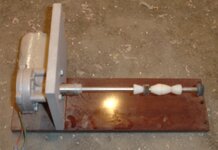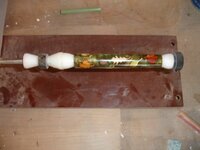I will add my 2 yen :wink: :
"In the past couple of weeks I have goofed a bunch of pens and I think I'm just trying to do too much, too fast."
The attitude and perception (that I see) for many new to turning pens - is that the cutting, drilling, glueing and assembling, turning and shaping is 90% of the work and time. WRONG!
PLAN for the finish to take 1/3 to 1/2 of the pen making time - until experience helps you reduce the time for a consistent finish. On flat work, it can take 2 days to a week to cut and assemble a fine piece of furniture. Then it will take 2 or more weeks for the finish. Too many people in home workshops will spend a week building very nice objects and try to rush the finish by spending 2 to 6 hours on the finish. It shows, but the maker doesn't want to hear it. Same for pens. The "finish" IS the presentation of the work. The "finish" deserves from the pen maker - the attitude that it is close to half of the process, not the quick end to a means.
Until considerable experience is gained - as it concerns variations in the temp, humidity and wood type from early morning to late evening, - rushing to complete a pen only complicates things. The above variables can be controlled to some extent, but an awareness of and adjustment for them is a must.
Do what George recommended by playing with some pine blanks. I did exactly that about 2 1/2 years ago over the course of several months. I also learned what to do in high humidity days, low humidity days, cold days, cool days and warm days. It changes from situation to situation, but I learned the variables and can make a good finish in each situation. The experience was worth it. My goal during this time was never a "finished pen" but "consistent finishes". The "finished pen" was a bonus. Now I enjoy the finishing process as much as the turning.
Lee;
You are square on! I had almost 3 days with nothing else to do SOOOO I turned out some pens, 1 was a pen that is going to a very special friend in Texas, Nice kit Jr.Statesman sitting inside some of Nolan's Very Nice Amboyna Burl, Turning was a breeze, the wood was excellent, it cooperated beautifully, I probably spent close to an hour and a half applying CA. Then I turned a couple more trying William Young's method of BLO/CA, I did a Jr Gent is a Malle Burl also a pleasure to turn and bring to the point of applying the finish, I applied 6 coats, 4 or 5 days latter, I looked at both pens under a good lighting system (we had sunshine today) Much quicker, Now I'm faced with a problem There is a profound difference in the time, and I think overall look, Mr.Young's being the fastest, His Finnish enhances the grain or figure of the wood, But I can't get the same glass finish I can with CA.
I also did 5 sets of blanks for slimlines since I'm doing THE COUNTY'S BIGGEST ART SHOW this week end. Ok so there's only about 3 to 5 thousand visitors total to the show and it's heldl at different studios, there are 14 juried artists, exhibiting in 3 locations, These pens I spray painted with Delft Gloss Lacquer last Saturday night, I applied between 4 and 6 coats since I didn't want sags and runs, I warmed the can up in Hot water,(it was about 50 degrees out side) .
Today I started sanding and polishing them, They look GOOD, In reality, I probably spent more time on one of these silly Slimline table fodder $ 20-$25.
pens, than I did on a pen that is also trying to be part of a spiritual gift as well as a tangible personal Memento.
The Lacquer looks Very Nice, Very slight grain enhancement Real nice gloss, not like a killer CA or a 6-8 coat wipe on Polly, but that is a very time consuming finish for me, and I never got the results a few have had.
I think a multistage rod turning system would be great, I wonder if the current rod varnishes would adhere to wood that has been wiped with BLO after the oil had dried for a week or so?
I have a machine controller that can handle up to 6 servo or stepper motors , but my system board only handles 4, I think I'm going to build a single unit and see if I like it, I still want to present the best possible finish to a pen that represents my name, and I really had let some junk through, What difference does it make between a slimline and an Imperial or Emperor ?? What difference, either pen carries my name, SO I still don't think THE perfect finish for all applications has come round yet.
Exit stage Right.


